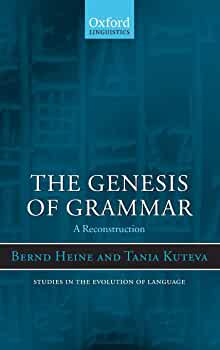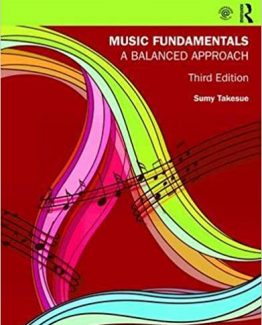The Genesis of Grammar: A Reconstruction by Bernd Heine, ISBN-13: 978-0199227761
[PDF eBook eTextbook]
- Publisher: Oxford University Press (November 24, 2007)
- Language: English
- 352 pages
- ISBN-10: 0199227764
- ISBN-13: 978-0199227761
This book reconstructs what the earliest grammars might have been and shows how they could have led to the languages of modern humankind.
Like other biological phenomena, language cannot be fully understood without reference to its evolution, whether proven or hypothesized,” wrote Talmy Givón in 2002. As the languages spoken 8,000 years ago were typologically much the same as they are today and as no direct evidence exists for languages before then, evolutionary linguists are at a disadvantage compared to their counterparts in biology. Bernd Heine and Tania Kuteva seek to overcome this obstacle by combining grammaticalization theory, one of the main methods of historical linguistics, with work in animal communication and human evolution. The questions they address include: do the modern languages derive from one ancestral language or from more than one? What was the structure of language like when it first evolved? And how did the properties associated with modern human languages arise, in particular syntax and the recursive use of language structures? The authors proceed on the assumption that if language evolution is the result of language change then the reconstruction of the former can be explored by deploying the processes involved in the latter. Their measured arguments and crystal-clear exposition will appeal to all those interested in the evolution of language, from advanced undergraduates to linguists, cognitive scientists, human biologists, and archaeologists.
Table of Contents:
Contents
Preface
List of abbreviations
1 Introduction
1.1 Questions and approaches
1.1.1 Previous work
1.1.2 Assumptions
1.1.3 The present approach
1.1.4 On uniformitarianism
1.2 Grammaticalization
1.2.1 Methodology
1.2.2 Problems
1.3 The present volume
2 An outline of grammatical evolution
2.1 Introduction
2.2 Layers
2.2.1 Nouns and verbs
2.2.2 The third layer: adjectives and adverbs
2.2.3 The fourth layer: demonstratives, adpositions, aspects, and negation
2.2.4 The fifth layer
2.2.5 The final stages
2.2.6 Treating events like objects
2.3 Evidence from signed languages
2.4 A scenario of evolution
2.5 Conclusions
3 Some cognitive abilities of animals
3.1 Introduction
3.2 What linguistic abilities do animals have?
3.2.1 Communicative intentions
3.2.2 Concepts
3.2.3 ‘‘Lexicon’’
3.2.4 Functional items
3.2.5 Compositionality
3.2.6 Argument structure
3.2.7 Linear arrangement
3.2.8 Coordination
3.2.9 Taxonomic concepts
3.3 Discussion
3.3.1 Problems
3.3.2 Language-like abilities in animals
3.3.3 Grammaticalization in animals?
3.4 Conclusion
4 On pidgins and other restricted linguistic systems
4.1 Introduction
4.2 Kenya Pidgin Swahili (KPS)
4.3 The rise of new functional categories
4.4 Discussion
4.5 Grammaticalization in other pidgins
4.6 A pidgin window on early language?
4.7 Other restricted systems
4.8 An elementary linguistic system?
4.9 Conclusion
5 Clause subordination
5.1 Introduction
5.2 Expansion
5.3 Integration
5.3.1 Relative clauses
5.3.2 Complement clauses
5.3.3 Adverbial clauses
5.3.4 From complementizer or relativizer to adverbial clause subordinator
5.4 Discussion
5.5 Conclusions
6 On the rise of recursion
6.1 What is recursion?
6.1.1 A definition
6.1.2 Manifestations
6.1.3 Simple vs. productive recursion
6.1.4 Embedding, iteration, and succession
6.1.5 Treatment of recursion in linguistic description
6.1.6 Are there languages without recursion?
6.1.7 Discussion
6.2 Animal cognition
6.3 The noun phrase
6.3.1 Attributive possession
6.3.2 Modifying compounding
6.3.3 Adjectival modification
6.3.4 Conclusion
6.4 Clause subordination
6.4.1 Case studies
6.5 Loss of recursion
6.6 Conclusions
7 Early language
7.1 Grammatical evolution
7.1.1 Layers
7.1.2 From non-language to language
7.1.3 Lexicon before syntax
7.1.4 Word order
7.1.5 Functions of early language
7.1.6 Who were the creators of early language?
7.1.7 Did language arise abruptly?
7.2 Grammaticalization—a human faculty?
7.3 Looking for answers
7.4 Conclusions
References
Index
Author index
Bernd Heine is Emeritus Professor of Linguistics at the Institute of African Studies, University of Cologne. His 33 books include Possession: Cognitive sources, forces, and grammaticalization (CUP, 1997); Auxiliaries: Cognitive Forces and Grammaticalization (OUP, 1993); Cognitive Foundations of Grammar (USA, 1997); with Derek Nurse, African Languages: An Introduction (CUP, 2000), A Linguistic Geography of Africa (CUP, to appear 2007). Tania Kuteva is Professor of English Linguistics at the University of Dusseldorf and author of Auxiliation: An Enquiry into the Nature of Grammaticalization (OUP, 2001). Bernd Heine and Tania Kuteva are the joint authors of World Lexicon of Grammaticalization (CUP, 2002) and Language Contact and Grammatical Change (CUP, 2005), and The Changing Languages of Europe (OUP, 2006).
What makes us different?
• Instant Download
• Always Competitive Pricing
• 100% Privacy
• FREE Sample Available
• 24-7 LIVE Customer Support





